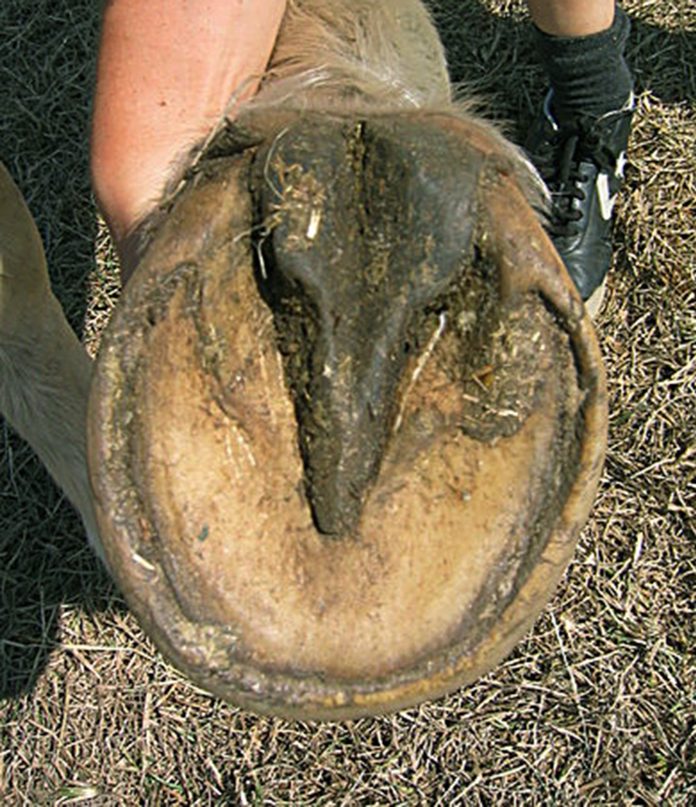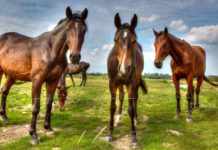
Showing a healthy (unshod) hoof at the end of a 100 mile endurance ride. The horse had completed a 50 mile ride 48 hours earlier.
Part I: The need for persuasion
It will soon be 150 years since the publication of ‘The Origin of Species,’ perhaps the most important book ever written. Despite the overwhelming evidence in support of the theory of evolution and, more importantly, the failure of all attempts to disprove it, acceptance of the truth of the theory by the general public is far from complete. Even in the UK, the birthplace of Darwin, one recent poll suggests less than half the population accepts evolution (1). If the truth about a subject of such importance is not understood and, therefore, not accepted, it is no surprise that new knowledge on less important topics fails to be applied. This article examines some of the reasons responsible for the delay in applying recent advances in horse welfare and suggests ways of overcoming the inertia.
A less memorable version of Mark Twain’s thought is “Truth travels slowly and falsehood moves fast.” Bad news spreads like lightning, whereas good news has the velocity of a glacier. Why is this? Everyone has heard that two Strasser Hoofcare Professionals were prosecuted in the UK and found guilty of cruelty. I wonder how many know that one of the defendants has lodged an appeal. How was it that these prosecutions, of two people deeply committed to improving equine welfare, were ever filed in the first instance? And, with terrible irony, how was it that they were filed by a welfare organization, the RSPCA, that should have applauded and supported their commitment rather than taken them to court. If the RSPCA and its advisors had understood the research published since the start of the millennium, they would have realized that shoeing was an indisputable act of cruelty (2-7). Those who try to rehabilitate shod horses should be praised not persecuted. How can such disconnects arise? As Julian Huxley remarked, “False thinking brings wrong conduct.”
With regard to hoof care, blindness to the truth is more ingrained than Mark Twain’s example, in which truth and falsehood apparently jumped out of the starting gate together. The truth on the hoof has to combat a medieval idea that has had a thousand year start. As John Maynard Keynes wrote, “The difficulty lies, not in the new ideas, but in escaping the old ones… which ramify into every corner of our minds like the clinging roots of an old juniper.”
Shoes are not protectors of the feet. They damage and deform the feet, harm and disable the whole horse (8). Shoeing a horse is disturbingly analogous to the practice of footbinding a girl. Both practices:
• Were dreamed-up in the 10th century AD
• Have persisted for at least a thousand years.
• Were initiated by the elite and spread to poison a population
• Victimized the very young (four-year-old girls and yearling Thoroughbreds)
• Caused and continue to cause immense suffering.
• Deform the foot, prevent its growth and foil its function
• Involve near total ‘house’ arrest
• Result in huge economic losses and shortened life spans
• Are cruel
• When discontinued, a major remodeling of bone and soft tissues follows. If the deformity was advanced, rehabilitation can be both painful and prolonged (two things the RSPCA and jurors failed to appreciate)
Footbinding persisted for a thousand years and shoeing still flourishes in the 21st century, with an estimated 100,000 practitioners on the planet. The anti-footbinding movement commenced with the Taiping Rebellion of 1850 in which 30 million died. Footbinding was formally banned in 1911. The anti-shoeing movement has taken longer to get underway but the battle to reform has commenced. Some people have already been hurt.
Thanks to two pioneers, a veterinarian in Germany, Dr.Hiltrud Strasser (8), and a farrier in the USA, Jaime Jackson (9), indisputable evidence disproving the claim that domesticated horses need shoes has been available for over a decade. We live in an information age and, as a result, many horse owners have been quick to recognize the validity of the evidence and have unshod their horses. Yet strangely, the information is not being adopted with the same enthusiasm by veterinarians and farriers as a group, nor welcomed and acted on by welfare organizations and national federations. Surely, these are the very people that should be leading the reform.
Why is it that layman are setting an example by making use of the research, when, as judged by the scientific literature, veterinarians as a group have greeted the advance with a majestic silence and have shown no eagerness to engage in open debate on this topic. Science advances by a process of falsification. Every scientific hypothesis is vulnerable to disproof. Significantly, in ten years, no one has even attempted to disprove the barefoot hypothesis. Quite apart from the many books on barefoot management now published by both Strasser and Jackson, why is it that a long and supportive article by Dr.Tomas Teskey (10) in a veterinary journal has also remained unchallenged? How did this article escape the notice of the advocates of shoeing? Teskey, who was a farrier before he became a veterinarian, wrote, “Shod horses have historically represented what has been thought of as a ‘higher level’ of care in my area and throughout the equine industry, received ‘better’ nutrition, housing, and management than barefoot horses. However, in my practice, the incidence of limb diseases and injury is 70% higher amongst shod horses.”
No Knights-of-the-Iron-Shoe have appeared in the lists (the scientific journals) to challenge the Knights-of-the-Naked-Hoof. Why is this? In the spirit of medieval times, I throw down my gauntlet. As nothing by way of refutation has been published in the last ten years, I claim that the Knights-of-the-Iron-Shoe have – by their very silence – conceded defeat in the jousting tournament of science.
The root of the resistance
On the 29th of April, 2008 a book will be published that, amongst many other things, helps to explain the silence of veterinarians in practice, if not that of research clinicians in veterinary schools (11). This is Joe Camp’s book, “The Soul of a Horse,” a factual yet emotional story in support of natural horsemanship (see www.thesoulofahorse.com). A book of this quality is capable of not only changing the attitude of the general public (something much needed when jurors can be so misled) but also the horse world.
Joe Camp draws attention to a reason why equine practitioners as a whole have failed to support barefoot management. It might be understandable that farriers would (mistakenly I believe) regard iron-free hoof care as a threat to their livelihood but why veterinarians? Here is what Joe Camp’s own veterinarian told him that, as he writes, “chilled my blood and made me very sad.” With his permission, I’m quoting below from p88.
Even with existing clients with whom he has good relationships, Dr.Matt has lost patients because he recommended that shoes come off.
The owner calls the farrier about pulling the shoes.
The farrier explains, that “Most vets don’t know much about feet because they don’t work with feet. And, well, you should really think about it before pulling the shoes.” Those words were actually spoken to me by a farrier.
In the above example, either the vet or the farrier is usually going to wind up losing a client because the last thing owners want are folks who disagree about the treatment for their horses. Especially if the owner doesn’t have a clue about which one is right.
The very sad thing about all this is that all the equine vets in the country should be educating themselves on the magical things that can be accomplished with the barefoot wild horse model. And they should be talking to clients about it. But the truth is that it would be difficult indeed for a vet to make it in a community in which he has alienated all the farriers.”
And another comment from Joe Camp …
“All populations of modern horses retain the ability to revert to the feral state
The so-called domestic horse and the wild horse are genetically the same. The wild horse model works because the so-called domestic horse and the wild horse are genetically identical. Think seriously about it every time you hear someone say that what they do for a living is better for your horse than what the horse would do for itself in the wild. Mother nature knows best.”
The irony is that while owners are adopting barefoot management programs with enthusiasm and success, they are obliged to do this in the face of resistance from veterinarians and farriers, the very people that they would normally look to for support. For a veterinarian to say that a barefoot horse cannot work is akin to an engineer saying a bumblebee cannot fly.
Part II: The art of persuasion
Another book was published last year that provides us with further guidance. This is the New York Times Bestseller by Chip and Dan Heath, “Made to Stick.” (12). The authors analyze the anatomy of ideas and recognize six principles that can make our ideas more likely to stick. The principles are listed under the mnemonic ‘SUCCESs’
• Simplicity
• Unexpectedness
• Concreteness
• Credibility
• Emotion
• Stories
I would like to review these principles and suggest how they might be applied to the barefoot idea.
1. Simplicity
How do we change attitudes? A crucial way is by “example. example, example,” a variation of the house seller’s mantra, “location, location, location.” With the help of barefoot trimmers, educated horse owners have been providing this example for a decade (5).
But how do we do it through the power of the written word? First, don’t ‘bury the lead.’ Find the core of the idea and state it up front. For example …
Horse’s hooves should expand and contract with every step. They can’t do this if their hoof walls are clamped with an iron hoop and crucified with seven nails.
2. Unexpectedness
Use the element of surprise to get attention. To maintain attention, point out the gaps in knowledge and thereby generate curiosity to keep the pages turning.
Satire relies on the unexpected. I have recently tried my hand at this to ridicule the Bronze Age idea of bitting (13). The practice of shoeing is equally bizarre, so it is fair game for satire.
But building on the core idea above …
Horse’s hooves should expand and contract with every step, because each hoof acts as a supplementary pump for the circulation of blood. A horse has at least five hearts, one in the chest and four in the feet.
3. Concreteness
Beware of using abstract terms and, as much as possible, use concrete images that conjure up something that can be touched, seen or heard.
Joe Camp suggests a line that is splendidly ‘concrete.’ Save money and save your horse at the same time
But building again on the core idea …
Horse’s hooves should expand and contract with every step to reduce the load on the heart but also to act as shock absorbers at the trot or faster paces. And talking of motion, horses should be in some sort of motion most of the 24-hour day. A stable is a prison cell and – for a mammal as large as a horse – a very small cell. The standard ‘cell’ for a horse is equivalent to incarcerating a man in a telephone kiosk.
4. Credibility
How do we make people believe our ideas? Can we cite any figures of authority by way of expert witnesses? Fine if we can … external credibility is always effective. Internal credibility works well for the BitlessBridle with the ‘try before you buy’ pitch (i.e. money back warranty after 30 days). This works because dramatic improvements are apparent, even on day one. But this pitch is not applicable to the barefoot program, in which, after years of shoe-induced deformity, rehabilitation can be lengthy and difficult. One could ask horsemen a question that would encourage them to test the credibility of the idea for themselves,
Which would you rather trust, 60 millions years of tried and tested natural selection or the crude and impertinent selection of some anonymous Saxon?
The word ‘impertinent’ can be better understood with the help of a time line …
The foot of the horse is a triumph of engineering. Starting with a four-toed mammal the size of a fox terrier, its design has been shaped by 60 million years of evolution. The one-toed modern horse (equus caballus) evolved about a million years ago. Let’s put aside the first 59 million years of development and reduce the last million to a 24-hour time scale. Within this period, modern man (homo sapiens) did not evolve until about 11.10 pm. He first domesticated the horse around 11.53 pm and did not start nailing iron clamps on its toes until some time after 11.58 pm. Attempts to improve the horse by selective breeding commenced about 17 seconds before midnight. This perspective assures us that the horse’s foot today cannot be markedly different from the unshod foot of horses in the Greek and Roman armies.
5. Emotions
How do we get people to care about our ideas? Belief in an idea (credibility) is not enough by itself; we also have to make them care. The authors recommend appealing to self-interest to get a message across. Spell out ‘the benefit of the benefits.’ Appeal to the user with the WIIFY – ‘what’s in it for you – principle (pronounced ‘whiffy’). Yes, the unshod horse has increased circulation in its hooves and, therefore, increased sensory input for balancing and knowing where to put its feet. But what is the benefit of the benefit? What’s in it for you? And the answer might be, “When your shod horse stumbles, you can be killed. Are you sure you want to take that risk?”
Another argument could be framed on the likelihood that a shod horse has contracted heels and pain in the navicular region. “Do you want to replace your horse when he’s nine because he develops navicular disease?” The possibilities are endless. A similar question could legitimately be based on the increased risk of a shod horse developing laminitis. Don’t forget the importance of the ‘you’ word. Don’t say, “When a shod horse stumbles, its rider can be killed” but, “When your horse stumbles, you can be killed.”
The increased traction of the barefoot horse in all conditions can be appealed to, “Imagine not having to worry about snow balling-up in your horse’s hoof” “Imagine reducing the risk of your horse slipping on the road,” etc., etc.
Though a four-year-old Chinese girl with bound feet might have survived into adolescence and married, she was increasingly crippled as an adult and her life shortened. So it is with the shod and stabled horse. Solitary confinement is bad enough for a herd animal but, in addition, the shoe acts like a slow poison. Its worst effects become apparent in maturity when a horse becomes crippled with laminitis or navicular disease.
Returning to our core idea …
Shoeing clamps the feet and reduces them in size. It condemns a horse to deformity of the feet, many limb diseases and a shortened life span.
Invoking self-interest should not stop at the level of appealing to the more basic human needs such as safety and financial economy. Appeals can be made to many people’s desire to show affection. Increasingly, owners are keener than ever to improve the quality of life of their much-loved horse. One can appeal to , an owner’s wish to achieve esteem, to learn more, to enjoy beauty, and reach their full potential in an endeavor that interests them and in which they can make some contribution. This last phrase is the true source of happiness. Because of this it is also one of the most powerful foundations for an appeal.
6. Stories
Read Joe Camp’s book … he uses the emotion principle with the pen of a master, to show people how they can improve the life of their horse and their own life. He does it by telling stories. He believes that the best stories are always founded in conflict. And the conflict does not always have to be overcome; the story is the struggle.
Stories prepare us to act more quickly and effectively. As part of this they can be powerful persuaders in the business of getting people to accept new ideas, they are wonderful teaching tools. As the brothers Heath explain, stories are “flight simulators for the brain.” And the most inspiring stories do not even have to be created. The best ones simply have to be spotted when they occur in real life; spotted and captured … ‘put salt on their tails.’ Carry a notebook and pencil.
The brothers Heath recognize three basic story plots: challenge, connection and creativity. In the barefoot world, all three plots occur, over and over again. For example, there is the triumph-of-willpower-over adversity and the underdog story (the challenge plot); the help-in-the-time-of-distress and the building-a-relationship story (the connection plot); and the problem solving and mental breakthrough story (the creativity plot). As Joe Camp points out, all three are really conflict plots.
The problem with a factual message and logical reasoning (the sort that most scientists tend to generate) is that it hits the listeners between the eyes and they instinctively respond by fighting back. If I inform a rider of a shod horse that she is being cruel, this will make her defensive and angry. But if I tell her a story about a rider who has been inadvertently cruel out of ignorance, who came to recognize her mistake and removed her horse’s shoes with wonderful results, she will identify with the heroine and be more likely to follow suit.
Here is a sort of fable that further emphasizes man’s impertinence …
What would the genius inventor of a supersonic plane say if, after having spent a lifetime designing, developing and testing his plane, it was subsequently encumbered by some non-engineer with a crude addition that paid no respect to the thought and ingenuity that had already been invested in the original design? Imagine a pair of dustbins being welded to the underside of the precisely engineered wings of his supersonic plane. For ‘genius inventor,’ read evolution. For ‘plane,’ read horse. For ‘dustbins,’ read horseshoes.
But real life stories are still the most effective and, in the barefoot world, there are so many happy endings. Think of the thousands of healthy, barefoot horses still living today who were under sentence of death, when shod, because they were unworkable.
The Heath brothers’ summary goes like this. Stories are almost always Concrete. Most of them have Emotional and Unexpected elements. The hardest part is making sure they’re Simple – that they reflect your core message. A credible idea makes people believe. An emotional idea makes people care and the right stories make people act.
One factor is yet missing from the six principles … time. We must be patient and plan to live long if we want to see the full flowering of the barefoot movement. As Thomas Paine observed in 1776, “Time makes more converts than reason.”
Conclusions
We need to educate the next generation of riders, veterinarians and non-ferrous farriers. “Catch ‘em young.” Talk to members of the Pony Club and 4H groups. Youngsters are not squeamish about changing the attitude of their friends and enemies. At that age they can get away with being mercilessly direct. A recent email from the President of a humanitarian and educational equine association in Switzerland tells the story. He explained how, as an association, they try to play fair and not put too much pressure on adult ‘iron-lovers’ but give them time to learn the difference between tradition and science (14, 15). His pupils however, mostly girls between 10 and 16 years old, are not so tolerant. “It is incredible,” he writes, “how this new generation is sensible to horse wellness. They just cannot stay quiet when they meet other young riders using ironed hoof and mouth horses, accusing them of cruelty and being prehistoric-minded people. It is so funny!”
Such attitudes in the young generation will make a difference. I am reminded of Maurice Chevalier’s song from Gigi, and I sing along, “Thank heaven, for little girls.”
Education is the only way to improve acceptance of the theory of evolution and education is also the only way to promote the application of advances in equine welfare. Education, a word derived from the Latin root dux, meaning ‘leader’ should employ all of Heaths’ six principles to get the facts across. But unless we are talking to skeptical scientists, I agree with Joe Camp that emotion will always have the edge over bare facts unadorned. Curiously, unlike the situation with the theory of evolution that is well accepted by scientists but has yet to convince the general public, with the theory of barefoot management it is the other way around. The general (i.e. horse-riding) public is accepting the theory in ever-increasing numbers, it is the professionals that are harder to convince.
I hope that I am misinformed and would love to hear that I am but I know of no school of veterinary medicine in any part of the world that has updated their curriculum on the horse’s foot to include the paradigm change from shod to unshod. Many vet schools have farriers on their staff and, again, as far as I am aware, none of these farriers have hung up their hammers. Where is the leadership that students have a right to expect? Research funding on the horse’s foot is still being awarded to research workers who appear to be unaware that the horseshoe is the major cause of the two most serious scourges of the horses foot, navicular disease and laminitis. The Knights-of-the-Naked-Hoof are not being invited to speak at veterinary conferences and their articles are rejected for publication when submitted to peer-reviewed veterinary journals. The majority of horsemen’s journals are still advocating shoeing.
Unlike the situation with evolution, there is one group of people in the horse world that possess the authority and the responsibility to legislate acceptance of proven scientific advances. These are the committee members of organizations that make the rules for horse sports, such as the FEI, national federations like the BHS and USEF, and the stewards of racing. Rules can and should be changed. And they should be changed now, not in a hundred years. It is unacceptable that current rules on equipment mandate cruelty.
We need to set a target. We should aim to have at least some horses competing barefoot and bitless by the time of the 2012 Olympic Games.
Acknowledgement
I am indebted to Joe Camp for his constructive critique of earlier drafts
References
References preceded with an asterisk are available online at www.bitlessbridle.com
1. Le Page, M (2008). “Evolution: A guide for the not-yet perplexed.” New Scientist, 19 April, pp 24-33
2. *Cook, W.R, Strasser, H, and De Beukelaer, E.R.J.M. (2007) “Compliance with physiology as the foundation for animal welfare guidelines: Exemplified by the rehabilitation of the horse’s foot & mouth.” Animal Welfare 2007 16(S) 166-167
3. *Cook, W.R, Strasser, H, and De Beukelaer, E.R.J.M. (2007) “Bitting and Shoeing Reclassified as Cruel.” Poster presentation for the University Federation of Animal Welfare/British Veterinary Association Ethics Committee International Symposium “Quality of Life: The Heart of the Matter.” Royal Society, London, UK
4. *Cook, W.R. (2008). Metal, myth and equine misery. Animal Welfare Science, Ethics and Law Veterinary Association Journal, January
5. *Cook W.R (2001) “Educated Owners and Barefoot Horses; an open letter to veterinarians.” Journal of Equine Veterinary Science, 21, 471-473
6. *Cook, W.R (2003) “Professional Dismissiveness of Equine Barefootedness.” Journal of Equine Veterinary Science, 23, 564 566
7. *Cook, W.R (2004) “Horseshoes Totally Indefensible.” Journal of Equine Veterinary Science. 24, 266
8. Strasser, H.(1998). “A Lifetime of Soundness: The keys to optimal horse health, lameness rehabilitation and the high-performance barefoot horse.” Sabine Kells. Qualicum Beach, BC, Canada
9. Jackson, J (1997). “The Natural Horse.” Star Ridge Publishing, Harrison, AR
10. *Teskey, Tomas G. (2005). “The Unfettered Foot: A paradigm change for equine podiatry.” Journal of Equine Veterinary Science, Vol. 25, pp 77-83
11. Camp, J (2008). “The Soul of a Horse: Life lessons from the herd.” Harmony Books, New York
12. Heath, C & Heath, D (2007). “Made to Stick: Why some ideas survive and others die.” Random House, New York.
13. *Cook, W.R. (2008) See the Happy Athlete: A ‘bit’ of satire.”
14. *Cook, W.R. (2006) “Tradition & the Status Quo or Science and Advance? A welfare reform in horse sport, currently denied.” Veterinary Times, UK November/December
15. *Cook, W.R. (2008) “On the Bit: A misleading and mischievous phrase.” Horses for Life, February


















